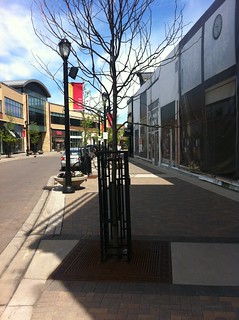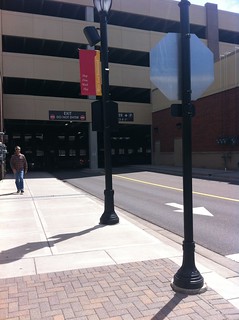When I first heard about the new development called the Shops at West End (WE), the Pet Shop Boys played in my head. My vision of The West End came from London, roughly the area between Piccadilly Circus and Charing Cross. They are not similarly located, London’s version is substantially closer to the City (2.2 miles) than the St. Louis Park version is to Nicollet Mall (4.2 miles). The spatial location similarities fell short, but as in its London namesake, WE is a restaurant and theatre district. Minnesota’s version opened as a new open-air shopping center at the northern end of St. Louis Park, roughly at the Southwest corner of the Junction I-394 and MN 100 in 2009. Now almost 4 years old, how well does WE work?
Below are some photos taken mid-day on an unseasonably nice Minnesota spring day. The site is not fully leased, as noted in this Biz Journal’s series of articles. The parking ramp is far from full.
The development into a real community remains unfinished, but while on-site it resembles the veneer of a Main Street (see this map), it is poorly connected with any of the neighboring retail parcels (including a Big Box center featuring a Costco and Home Depot across the street), and even the onsite offices are separated by a fortress of parking ramps.
The poor connections are not entirely the developer’s fault, the neighboring developments were designed without West End in mind, and geared to automobile travelers (go figure, located at the interchange of two major freeways). The onsite offices could have easily been above the shops, so that office workers passed the stores going into and out of work. This ground floor retail would have increased pedestrian traffic compared with the current layout (at the expense of fully climate controlled travel for lessees of the office space).
So the internal without respect to the external is inherently hampered. The site itself acknowledges all of its customers are drive up, it features several significant parking structures. The structures do dump pedestrians onto the Main Street (West End Boulevard), but the interface is far from seamless, with some longish unpleasant-ish, malodorous walks within the structure, so while it tries to play nice between car and pedestrian, it falls short. West End Boulevard aims for the shopping street experience, but it still gives more real estate to the movement and storage of cars than pedestrians. West End Boulevard is no Shaftesbury Avenue (which itself was a 19th century slum clearance measure, so some good can come of urban renewal in the right hands and given enough time).
With some artistry, the West End could be tied into future redevelopments of neighboring sites, but I don’t see it happening, this suburb is too far gone, street grids are too hard to reorganize, and no good East-West corridor was established through the site. At a larger scale, St. Louis Park is dissected by both freeways and railroad tracks. Driving from Excelsior and Grand to The Shops at West End is 4.4 miles, and for all practical purposes requires freeway use. Walking is given as 3.4 miles, but is on the circuitous side, requiring 7 turns.
Back at the WE, trees are under-developed (The developer could have installed older trees). More significantly, West End Boulevard is too narrow, and as a result, has too much shade and too little sunlight, even in the middle of the day. A wider street would have helped in this regard.
The roads and sidewalks are bricked, and not just brick highlights, but a fully bricked road. In a different climate, this might survive. I have doubts this will age well under traffic and Minnesota winters. The main street is not straight. It could have been straight, but the developer chose curvy. This seems to be popular in shopping malls now (so you can’t see the end, there is excitement at every bend, there is more retail surface area), but it feels wrong at this scale, like it’s wobbly. Part of the problem is its narrowness. Of course all grids must bend at some point (the earth is not flat), but this short turning gives it a more suburban feeling in what is supposed be an urban-like (or urban-lite) experience. The real streets that West End Boulevard parallels (Duke Drive, Park Place Boulevard) are straighter, and oriented for the movement of cars.
The shops are not unique. I visited solely because of the multiplex movie theatre, which are getting more difficult to find in the cities. The theatre itself is upstairs in one building, which I guess makes sense, as no need to waste ground-floor retail on such a large structure, and I have seen this model in Town Centres in and around London. On the other hand, I passed the entrance before I figured out it was the theatre, the signage is not at all obvious at ground level, and the large highway-oriented signs suggest a different location for the entrance.
While the West End is not scheduled to get any significant transit stations any time soon (just like St. Louis Park’s other signature retail development: Excelsior and Grand), and unlike London’s counterpart, where you can’t turn around without falling into an Underground Station, there is a small park and ride lot one block north of the site at Park Place Boulevard and I-394. If this corridor were turned into a full-fledged Freeway Bus-Rapid Transit system (like the Red and Orange lines, as suggested by the Purple Line on this map by Kyril Negoda), there would be a natural station here. And BRT is technically quite feasible, what with the HOT lanes already in place. Tying that station into a real fine-grained local street network at the interchange may be the planners’ hope, but there is a lot of market coordination required to achieve that.




